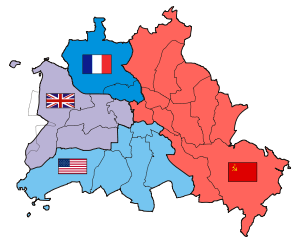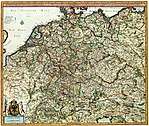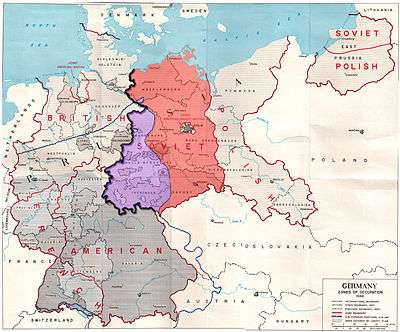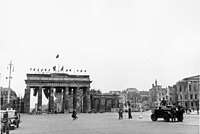Allied-occupied Germany
Allied-occupied Germany (German: Deutschland in der Besatzungszeit, literally: "Germany in the occupation period") was the state of Germany (German: Deutsches Reich) upon defeat of Nazi Germany in World War II, when the victorious Allies asserted joint authority and sovereignty over Germany as a whole, defined as all territories of the former German Reich west of the Oder–Neisse line, having declared the destruction of Nazi Germany at the death of Adolf Hitler (see 1945 Berlin Declaration). The four powers divided "Germany as a whole" into four occupation zones for administrative purposes under the United States, United Kingdom, France and the Soviet Union, respectively. This division was ratified at the Potsdam Conference (17 July to 2 August 1945). The four zones were as agreed in February 1945 by the United States, United Kingdom and Soviet Union meeting at the Yalta Conference; setting aside an earlier division into three zones (excluding France) proposed by the London Protocol.
Allied Occupation of Germany Alliierte Besetzung Deutschlands | |||||||||||||||
|---|---|---|---|---|---|---|---|---|---|---|---|---|---|---|---|
| 1945–1949 | |||||||||||||||
 French occupation zone British occupation zone[lower-alpha 3] US occupation zone Soviet occupation zone[lower-alpha 4] Saar Protectorate under the control of France | |||||||||||||||
| Status | Military occupation | ||||||||||||||
| Capital |
| ||||||||||||||
| Common languages | |||||||||||||||
| Governors (1945) | |||||||||||||||
• British zone | Bernard Montgomery | ||||||||||||||
• US zone | Dwight D. Eisenhower | ||||||||||||||
• French zone | Jean d.L. de Tassigny | ||||||||||||||
| Georgy K. Zhukov | |||||||||||||||
| Historical era | Cold War | ||||||||||||||
| 8 May 1945 | |||||||||||||||
| 5 June 1945 | |||||||||||||||
• Saar Protectoratea | 15 December 1947 | ||||||||||||||
| 23 May 1949 | |||||||||||||||
• East Germanyb | 7 October 1949 | ||||||||||||||
| 12 September 1990 | |||||||||||||||
| Population | |||||||||||||||
• 1945 | 64,260,000 | ||||||||||||||
• 1949 | 68,080,000 | ||||||||||||||
| Currency |
| ||||||||||||||
| |||||||||||||||
| Today part of | |||||||||||||||
| |||||||||||||||
 The four sectors and exclaves of Berlin | |||||||||||||||
Part of a series on the |
||||||||||
|---|---|---|---|---|---|---|---|---|---|---|
| History of Germany | ||||||||||
 | ||||||||||
| Topics | ||||||||||
| Early history | ||||||||||
| Middle Ages | ||||||||||
| Early Modern period | ||||||||||
| Unification | ||||||||||
|
||||||||||
| German Reich | ||||||||||
|
||||||||||
| Contemporary Germany | ||||||||||
|
||||||||||
|
| ||||||||||
At Potsdam, the United States, United Kingdom and the Soviet Union approved the detachment from Germany as a whole of the German eastern territories east of the Oder–Neisse line, with the exact line of the boundary to be determined at a final German Peace Treaty. This treaty was expected to confirm the shifting westward of Poland's borders as the United Kingdom and the United States committed themselves to support in any future peace treaty the permanent incorporation of eastern Germany into Poland and the Soviet Union. From March 1945 to July 1945, these former eastern territories of Germany had been administered under Soviet military occupation authorities, but following the Potsdam Conference they were handed over to Soviet and Polish civilian administrations and ceased to constitute part of Allied-occupied Germany.
In the closing weeks of fighting in Europe, United States forces had pushed beyond the agreed boundaries for the future zones of occupation, in some places by as much as 320 km (200 miles). The so-called line of contact between Soviet and U.S. forces at the end of hostilities, mostly lying eastward of the July 1945-established inner German border, was temporary. After two months in which they had held areas that had been assigned to the Soviet zone, U.S. forces withdrew in the first days of July 1945.[1] Some have concluded that this was a crucial move that persuaded the Soviet Union to allow American, British and French forces into their designated sectors in Berlin which occurred at roughly the same time (July 1945), although the need for intelligence gathering (see Operation Paperclip) may also have been a factor.[2]
Territories annexed by Germany between 1938 and 1945
All territories annexed by Germany before the war from Austria and Czechoslovakia were returned to these countries. The Memel Territory, annexed by Germany from Lithuania before the war, was annexed by the Soviet Union in 1945 and transferred to the Lithuanian SSR. All territories annexed by Germany during the war from Belgium, France, Luxembourg, Poland and Yugoslavia were returned to their respective countries.
Occupation zones

American Zone of Occupation
The American zone in Southern Germany consisted of Bavaria with its traditional capital Munich and Hesse with a new capital in Wiesbaden, and of parts of Württemberg and Baden. Those formed Württemberg-Baden and are the northern portions of the present-day German state of Baden-Württemberg.
The ports of Bremen (on the lower Weser River) and Bremerhaven (at the Weser estuary of the North Sea) were also placed under U.S. control because of the U.S. request to have certain toeholds in Northern Germany. At the end of October 1946, the American Zone had a population of:
- Bavaria 8.7 million
- Hesse 3.97 million
- Württemberg-Baden 3.6 million
- Bremen 0.48 million[3]
The headquarters of the American military government was the former IG Farben Building in Frankfurt am Main.
Media in Southern Germany and in Berlin
Following the complete closure of all Nazi German media, the launch and operation of completely new newspaper titles began by licensing carefully selected Germans as publishers. Licenses were granted to Germans not involved in Nazi propaganda to establish those newspapers, including Frankfurter Rundschau (August 1945), Der Tagesspiegel (Berlin; September 1945), and Süddeutsche Zeitung (Munich; October 1945). Radio stations were run by the military government. Later, Radio Frankfurt, Radio München (Munich) and Radio Stuttgart gave way for the Hessischer Rundfunk, Bayerischer Rundfunk, and Süddeutscher Rundfunk, respectively. The RIAS in West-Berlin remained a radio station under U.S. control.
British Zone of Occupation
By May 1945 the British and Canadian Armies had liberated the Netherlands and had conquered Northern Germany. With the German surrender the Canadians returned home, leaving Northern Germany to be occupied by the British.
In July the British withdrew from Mecklenburg's capital Schwerin which they had taken over from the Americans a few weeks before, as it had previously been agreed to be occupied by the Soviet Army. The Control Commission for Germany (British Element) (CCG/BE) ceded more slices of its area of occupation to the Soviet Union – specifically the Amt Neuhaus of Hanover and some exclaves and fringes of Brunswick, for example the County of Blankenburg, and exchanged some villages between British Holstein and Soviet Mecklenburg under the Barber-Lyashchenko Agreement.
Within the British Zone of Occupation, the CCG/BE re-established the German state of Hamburg, but with borders that had been drawn by Nazi Germany in 1937. The British also created the new German states of:
- Schleswig-Holstein – emerging in 1946 from the Prussian Province of Schleswig-Holstein;
- Lower Saxony – the merger of Brunswick, Oldenburg, and Schaumburg-Lippe with the state of Hanover in 1946; and
- North Rhine-Westphalia – the merger of Lippe with the Prussian provinces of the Rhineland (northern part) and Westphalia – during 1946–47.
Also in 1947, the American Zone of Occupation being inland had no port facilities – thus the Free Hanseatic City of Bremen and Bremerhaven became exclaves within the British Zone.
At the end of October 1946, the British Zone had a population of:
- North Rhine-Westphalia 11.7 million
- Lower Saxony 6.2 million
- Schleswig-Holstein 2.6 million
- Hamburg 1.4 million[3]
The British headquarters were originally based in Bad Oeynhausen from 1946, but in 1954 it was moved to Mönchengladbach where it was known as JHQ Rheindahlen.
 Flag used by ships registered in the British zone
Flag used by ships registered in the British zone Badge of the Control Commission for Germany
Badge of the Control Commission for Germany British armoured car, at the Brandenburg Gate in Berlin, 1950
British armoured car, at the Brandenburg Gate in Berlin, 1950 Road sign delimiting the British sector of occupation in Berlin, 1984
Road sign delimiting the British sector of occupation in Berlin, 1984
Belgian, Polish and Norwegian Zones
Army units from other nations were stationed within the British occupation zone. The Belgians were allocated a territory which was garrisoned by their troops.[4] The zone formed a 200 kilometres (120 mi) strip from the Belgian-German border at the south of the British zone, and included the important cities of Cologne and Aachen. The Belgian army of occupation in Germany (known as the Belgian Forces in Germany from 1951) became autonomous in 1946 under the command, initially, of Jean-Baptiste Piron.[5]
Belgian soldiers would remain in Germany until 31 December 2005.[6]
Polish units mainly from 1st Armoured Division also had a place in the occupation; they were stationed in the northern area of the district of Emsland as well as in the areas of Oldenburg and Leer. This region bordered the Netherlands and covered an area of 6,500 km2, and was originally intended to serve as a collection and dispersal territory for the millions of Polish displaced persons in Germany and western Europe after the war. Early British proposals for this to form the basis of a formal Polish Zone of Occupation, were however, soon abandoned due to Soviet opposition. The zone had a large camp constructed largely for displaced persons and was administered by the Polish government in exile. The administrative centre of the Polish occupation zone was the city of Haren the German population of which was temporarily removed. The city was renamed Maczków (after Stanisław Maczek) during the period 1945 to 1947. Once the British recognised the pro-Soviet government in Poland, and withdrew recognition from the London-based Polish government in exile, the Emsland zone became more of an embarrassment. Polish units within the British Army were demobilised in June 1947; and the expelled German populations allowed to return, the last Polish residents leaving in 1948.
In 1946, the Norwegian Brigade Group in Germany had 4,000 soldiers in Hanover; amongst whom was Willy Brandt (then a Norwegian citizen) as press attaché.
Another special feature of the British zone was the Enclave of Bonn. It was created in July 1949 and was not under British or any other allied control. Instead it was under the control of the Allied High Commission.
French Zone of Occupation
Despite its being one of the Allied Powers, the French Republic was at first not granted an occupation zone in Germany. Later, however, the British and American governments recognised the role of France during the war, and agreed to cede some western parts of their zones of occupation to the French Army.[7] In April and May 1945, the French 1st Army had captured Karlsruhe and Stuttgart, and conquered a territory extending to Hitler's Eagle's Nest and the westernmost part of Austria. In July, the French relinquished Stuttgart to the Americans, and in exchange were given control over cities west of the Rhine such as Mainz and Koblenz.[8] All this resulted in two barely contiguous areas of Germany along the French border which met at just a single point along the River Rhine. Three German states (Land) were established: Rheinland Pfalz in the North and West and on the other hand Württemberg-Hohenzollern and South Baden, who later formed Baden-Württemberg together with Württemberg-Baden of the American Zone.[9]
The French Zone of Occupation included the Saargebiet, which was disentangled from it on 16 February 1946. By 18 December 1946 customs controls were established between the Saar area and Allied-occupied Germany. The French zone ceded further areas adjacent to the Saar (in mid-1946, early 1947, and early 1949). Included in the French zone was the town of Büsingen am Hochrhein, a German exclave separated from the rest of the country by a narrow strip of neutral Swiss territory. The Swiss government agreed to allow limited numbers of French troops to pass through its territory in order to maintain law and order in Büsingen.
 French forces in front of the Brandenburg Gate in Berlin, 1946
French forces in front of the Brandenburg Gate in Berlin, 1946 Forces Françaises à Berlin (French Forces in Berlin) insignia after 1949
Forces Françaises à Berlin (French Forces in Berlin) insignia after 1949
At the end of October 1946, the French Zone had a population of:
- Rheinland Pfalz 2.7 million
- Baden (South Baden) 1.2 million
- Württemberg-Hohenzollern 1.05 million
(The Saar Protectorate had a further 0.8 million.)[3]
Luxembourg zone
From November 1945, Luxembourg was allocated a zone within the French sector.[10] The Luxembourg 2nd Infantry Battalion was garrisoned in Bitburg and the 1st Battalion was sent to Saarburg.[10] The final Luxembourg forces in Germany, in Bitburg, left in 1955.[10]
Soviet Zone of Occupation

The Soviet occupation zone incorporated Thuringia, Saxony, Saxony-Anhalt, Brandenburg and Mecklenburg-Vorpommern. The Soviet Military Administration in Germany was headquartered in Berlin-Karlshorst.
At the end of October 1946, the Soviet Zone had a population of:
- Saxony: 5.5 million
- Saxony-Anhalt 4.1 million
- Thuringia 2.9 million
- Brandenburg 2.5 million
- Mecklenburg 2.1 million[3]
Berlin
While located wholly within the Soviet zone, because of its symbolic importance as the nation's capital and seat of the former Nazi government, the city of Berlin was jointly occupied by the Allied powers and subdivided into four sectors. All four occupying powers were entitled to privileges throughout Berlin that were not extended to the rest of Germany – this included the Soviet sector of Berlin which was legally separate from the rest of the Soviet zone.
At the end of October 1946, Berlin had a population of:
- Western sectors 2.0 million
- Soviet sector 1.1 million[3]
Other German territory
In 1945 Germany east of the Oder–Neisse line (Farther Pomerania, the New March, Silesia and southern East Prussia) was assigned to Poland by the Potsdam Conference to be "temporarily administered" pending the Final Peace Treaty on Germany; eventually (under the September 1990 2+4 Peace Treaty) the northern portion of East Prussia became the Kaliningrad Oblast within the Soviet Union. A small area west of the Oder, near Szczecin, also fell to Poland. Most German citizens residing in these areas were subsequently expropriated and expelled. Returning refugees, who had fled from war hostilities, were denied return.
The Saargebiet, an important area of Germany because of its large deposits of coal, was turned into the Saar protectorate. The Saar was disengaged from the French zone on 16 February 1946. In the speech Restatement of Policy on Germany on 6 September 1946 the U.S. Secretary of State James F. Byrnes stated the U.S.' motive in detaching the Saar from Germany as "The United States does not feel that it can deny to France, which has been invaded three times by Germany in 70 years, its claim to the Saar territory."
By 18 December 1946 customs controls were established between the Saar and Allied-occupied Germany. Most German citizens residing in the Saar area were allowed to stay and keep their property. Returning refugees, who had fled from war hostilities, were allowed to return; in particular, refugees who had fled the Nazi dictatorship were invited and welcomed to return to the Saar.
The protectorate was a state nominally independent of Germany and France, but with its economy integrated into that of France. The Saar territory was enlarged at the expense of the French zone in mid-1946, early 1947 (when 61 municipalities were returned to the French zone), and early 1949. On 15 November 1947 the French currency became legal tender in the Saar Protectorate, followed by the full integration of the Saar into the French economy (customs union as of 23 March 1948). In July the Saar population was stripped of its German citizenship and became of Sarrois nationality.
Population
In October 1946, the population of the various zones and sectors was as follows:[3]
| State, sector, or other territory | Zone | Population |
|---|---|---|
| Bavaria | American | 8.7 million |
| Hesse | American | 3.97 million |
| Württemberg-Baden | American | 3.6 million |
| Bremen | American | 0.48 million |
| North Rhine-Westphalia | British | 11.7 million |
| Lower Saxony | British | 6.2 million |
| Schleswig-Holstein | British | 2.6 million |
| Hamburg | British | 1.4 million |
| Rhineland-Palatinate | French | 2.7 million |
| South Baden | French | 1.2 million |
| Württemberg-Hohenzollern | French | 1.05 million |
| Saxony | Soviet | 5.5 million |
| Saxony-Anhalt | Soviet | 4.1 million |
| Thuringia | Soviet | 2.9 million |
| Brandenburg | Soviet | 2.5 million |
| Mecklenburg-Vorpommern | Soviet | 2.1 million |
| Berlin (western sectors) | American, British, French | 2.0 million |
| Berlin (Soviet sector) | Soviet | 1.1 million |
| Saar Protectorate | separate French protectorate | 0.8 million |
Governance and the emergence of two German states
The original Allied plan to govern Germany as a single unit through the Allied Control Council broke down in 1946–1947 due to growing tensions between the Allies, with Britain and the US wishing cooperation, France obstructing any collaboration in order to unwind Germany into many independent states, and the Soviet Union unilaterally implementing from early on elements of a Marxist political-economic system (enforced redistribution of land, nationalisation of businesses). Another dispute was the absorption of post-war expellees. While the UK, the US and the Soviet Union had agreed to accept, house and feed about six million expelled German citizens from former eastern Germany and four million expelled and denaturalised Czechoslovaks, Poles, Hungarians and Yugoslavs of German ethnicity in their zones, France generally had not agreed to the expulsions approved by the Potsdam agreement (a decision made without input from France). Therefore, France strictly refused to absorb war refugees who were denied return to their homes in seized eastern German territories or destitute post-war expellees who had been expropriated there, into the French zone, let alone into the separated Saar protectorate.[11] However, the native population, returning after Nazi-imposed removals (e.g., political and Jewish refugees) and war-related relocations (e.g., evacuation from air raids), were allowed to return home in the areas under French control. The other Allies complained that they had to shoulder the burden to feed, house and clothe the expellees who had to leave their belongings behind.
In practice, each of the four occupying powers wielded government authority in their respective zones and carried out different policies toward the population and local and state governments there. A uniform administration of the western zones evolved, known first as the Bizone (the American and British zones merged as of 1 January 1947) and later the Trizone (after inclusion of the French zone). The complete breakdown of east–west allied cooperation and joint administration in Germany became clear with the Soviet imposition of the Berlin Blockade that was enforced from June 1948 to May 1949. The three western zones were merged to form the Federal Republic of Germany in May 1949, and the Soviets followed suit in October 1949 with the establishment of the German Democratic Republic (GDR).
In the west, the occupation continued until 5 May 1955, when the General Treaty (German: Deutschlandvertrag) entered into force. However, upon the creation of the Federal Republic in May 1949, the military governors were replaced by civilian high commissioners, whose powers lay somewhere between those of a governor and those of an ambassador. When the Deutschlandvertrag became law, the occupation ended, the western occupation zones ceased to exist, and the high commissioners were replaced by normal ambassadors. West Germany was also allowed to build a military, and the Bundeswehr, or Federal Defense Force, was established on 12 November 1955.
A similar situation occurred in East Germany. The GDR was founded on 7 October 1949. On 10 October the Soviet Military Administration in Germany was replaced by the Soviet Control Commission, although limited sovereignty was not granted to the GDR government until 11 November 1949. After the death of Joseph Stalin in March 1953, the Soviet Control Commission was replaced with the office of the Soviet High Commissioner on 28 May 1953. This office was abolished (and replaced by an ambassador) and (general) sovereignty was granted to the GDR, when the Soviet Union concluded a state treaty (Staatsvertrag) with the GDR on 20 September 1955. On 1 March 1956, the GDR established a military, the National People's Army (NVA).
Despite the grants of general sovereignty to both German states in 1955, full and unrestricted sovereignty under international law was not enjoyed by any German government until after the reunification of Germany in October 1990. Though West Germany was effectively independent, the western Allies maintained limited legal jurisdiction over 'Germany as a whole' in respect of West Germany and Berlin. At the same time, East Germany progressed from being a satellite state of the Soviet Union to increasing independence of action; while still deferring in matters of security to Soviet authority. The provisions of the Treaty on the Final Settlement with Respect to Germany, also known as the "Two-plus-Four Treaty", granting full sovereign powers to Germany did not become law until 15 March 1991, after all of the participating nations had ratified the treaty. As envisaged by the Treaty, the last occupation troops departed from Germany when the Russian presence was terminated in 1994, although the Belgian Forces in Germany stayed in German territory until the end of 2005.
A 1956 plebiscite ended the French administration of the Saar protectorate, and it joined the Federal Republic as Saarland on 1 January 1957, becoming its tenth state.
The city of Berlin was not part of either state and continued to be under Allied occupation until the reunification of Germany in October 1990. For administrative purposes, the three western sectors of Berlin were merged into the entity of West Berlin. The Soviet sector became known as East Berlin and while not recognised by the Western powers as a part of East Germany, the GDR declared it its capital (Hauptstadt der DDR).
Occupation policy

At the end of the war, General Eisenhower issued a non-fraternization policy to troops under his command in occupied Germany. This policy was relaxed in stages. By June 1945 the prohibition on speaking with German children was made less strict. In July it became possible to speak to German adults in certain circumstances. In September the policy was completely dropped in Austria and Germany.
Nevertheless, due to the large numbers of Disarmed Enemy Forces being held in Rheinwiesenlagers throughout western Germany, the Americans and the British – not the Soviets – used armed units of Feldgendarmerie to maintain control and discipline in the camps. In June 1946, these German military police units became the last Wehrmacht troops to surrender their arms to the western powers.
By December 1945, over 100,000 German civilians were interned as security threats and for possible trial and sentencing as members of criminal organisations.
The food situation in occupied Germany was initially very dire. By the spring of 1946 the official ration in the American zone was no more than 1,275 calories (5,330 kJ) per day, with some areas probably receiving as little as 700 calories (2,900 kJ) per day. In the British zone the food situation was dire, as found during a visit by the British (and Jewish) publisher Victor Gollancz in October and November 1946. In Düsseldorf the normal 28-day allocation should have been 1,548 calories (6,480 kJ) including 10 kilograms (22 lb) of bread, but as there was limited grain the bread ration was only 8.5 kilograms (19 lb). However, as there was only sufficient bread for about 50% of this "called up" ration, the total deficiency was about 50%, not 15% as stated in a ministerial reply in the British Parliament on 11 December. So only about 770 calories (3,200 kJ) would have been supplied, and he said the German winter ration would be 1,000 calories (4,200 kJ) as the recent increase was "largely mythical". His book includes photos taken on the visit and critical letters and newspaper articles by him published in several British newspapers; The Times, the Daily Herald, the Manchester Guardian, etc.[12]
Some occupation soldiers took advantage of the desperate food situation by exploiting their ample supply of food and cigarettes (the currency of the black market) to get to the local German girls as what became known as frau bait (The New York Times, 25 June 1945). Some soldiers still felt the girls were the enemy, but used them for sex nevertheless.[13]
The often destitute mothers of the resulting children usually received no child support. In the earliest stages of the occupation, U.S. soldiers were not allowed to pay maintenance for a child they admitted having fathered, since to do so was considered "aiding the enemy". Marriages between white U.S. soldiers and Austrian women were not permitted until January 1946, and with German women until December 1946.[13]
The children of African-American soldiers, commonly called Negermischlinge[14] ("Negro half-breeds"), comprising about three percent of the total number of children fathered by GIs, were particularly disadvantaged because of their inability to conceal the foreign identity of their father. For many white U.S. soldiers of this era, miscegenation even with an "enemy" white population was regarded as an intolerable outrage. African-American soldiers were therefore reluctant to admit to fathering such children since this would invite reprisals and even accusations of rape, a crime which was much more aggressively prosecuted by military authorities against African-Americans compared with Caucasian soldiers, much more likely to result in a conviction by court-martial (in part because a German woman was both less likely to acknowledge consensual sexual relations with an African-American and more likely to be believed if she alleged rape against an African-American) and which carried a potential death sentence. Even in the rare cases where an African-American soldier was willing to take responsibility for fathering a child, until 1948 the U.S. Army prohibited interracial marriages.[14] The mothers of the children would often face particularly harsh ostracism.[15]
Between 1950 and 1955, the Allied High Commission for Germany prohibited "proceedings to establish paternity or liability for maintenance of children."[14] Even after the lifting of the ban West German courts had little power over American soldiers.
In general, the British authorities were less strict than the Americans about fraternisation, whereas the French and Soviet authorities were more strict.
While Allied servicemen were ordered to obey local laws while in Germany, soldiers could not be prosecuted by German courts for crimes committed against German citizens except as authorised by the occupation authorities. Invariably, when a soldier was accused of criminal behaviour the occupation authorities preferred to handle the matter within the military justice system. This sometimes led to harsher punishments than would have been available under German law – in particular, U.S. servicemen could be executed if court-martialed and convicted of rape.[15] See United States v. Private First Class John A. Bennett, 7 C.M.A. 97, 21 C.M.R. 223 (1956).
Insurgency
The last Allied war advances into Germany and Allied occupation plans were affected by rumors of Nazi plans for insurgency (the Nazi Werwolf plan), and successful Nazi deception about plans to withdraw forces to Alpenfestung redoubt. This base was to be used to conduct guerrilla warfare, but the rumours turned out to be false. It has been estimated that no Allied deaths can be reliably attributed to any Nazi insurgency.[16]
Expulsion policy
The Potsdam conference, where the victorious Allies drew up plans for the future of Germany, noted in article XIII of the Potsdam Agreement on 1 August 1945 that "the transfer to Germany of German populations (...) in Poland, Czechoslovakia and Hungary will have to be undertaken"; "wild expulsion" was already going on.
Hungary, which had been allied with Germany and whose population was opposed to an expulsion of the German minority, tried to resist the transfer. Hungary had to yield to the pressure exerted mainly by the Soviet Union and by the Allied Control Council.[17] Millions of people were expelled from former eastern territories of Germany, Poland, Czechoslovakia, Hungary and elsewhere to the occupation zones of the UK, US, and USSR, which agreed in the Potsdam Agreement to absorb the post-war expellees into their zones. Many remained in refugee camps for a long time. Some Germans remained in the Soviet Union and were used for forced labour for a period of years.
France was not invited to the Potsdam Conference. As a result, it chose to adopt some decisions of the Potsdam Agreements and to dismiss others. France maintained the position that it did not approve post-war expulsions and that therefore it was not responsible to accommodate and nourish the destitute expellees in its zone. While the few war-related refugees who had reached the area to become the French zone before July 1945 were taken care of, the French military government for Germany refused to absorb post-war expellees deported from the East into its zone. In December 1946, the French military government for Germany absorbed into its zone German refugees from Denmark, where 250,000 Germans had found a refuge from the Soviets by sea vessels between February and May 1945.[11] These clearly were war-related refugees from the eastern parts of Germany however, and not post-war expellees.
Military governors and commissioners
See also
- Allied-occupied Austria
- German-occupied Europe
- History of Germany since 1945
- Interzonal traffic
- Occupation of Japan
Notes
- The two American exclaves in the British sector are Bremen.
- The quadripartite area shown within the Soviet zone is Berlin.
- The two American exclaves in the British sector are Bremen.
- The quadripartite area shown within the Soviet zone is Berlin.
References
- What Is to Be Done? Time, 9 July 1945
- Knowles, Chris (29 January 2014). "Germany 1945–1949: a case study in post-conflict reconstruction". History & Policy. Retrieved 19 July 2016.
- "I. Gebiet und Bevölkerung". Statistisches Bundesamt. Wiesbaden.
- Brüll, Christoph (2011). "Entre ressentiment et ré-éducation, L'Armée belge d'Occupation et les Allemands, 1945–1952" (PDF). Cahiers d'Histoire du Temps Présent. 23: 55–6.
- Brüll, Christoph (2011). "Entre ressentiment et ré-éducation, L'Armée belge d'Occupation et les Allemands, 1945–1952" (PDF). Cahiers d'Histoire du Temps Présent. 23: 55–94.
- Brüll, Christoph (2011). "Entre ressentiment et ré-éducation, L'Armée belge d'Occupation et les Allemands, 1945–1952" (PDF). Cahiers d'Histoire du Temps Présent. 23: 55.
- Reinisch, Jessica (2013). The Perils of Peace. OUP. p. 261.
- de Gaulle, Charles (1959). Mémoires de guerre : Le Salut 1944-1946. Plon. pp. 170, 207.
- Corey Campion, "Remembering the" Forgotten Zone": Recasting the Image of the Post-1945 French Occupation of Germany." French Politics, Culture & Society 37.3 (2019): 79-94.
- "L'Armée luxembourgeoise après la libération (1944–1967)". Armée.lu. Archived from the original on 30 July 2013. Retrieved 6 July 2013.
- Cf. the report of the Central State Archive of Rhineland-Palatinate on the first expellees arriving in that state in 1950 from other German states in the former British or American zone: "Beyond that [the fact, that until France took control of her zone west only few eastern war refugees had made it into her zone] already since summer 1945 France refused to absorb expellee transports in her zone. France, who had not participated in the Potsdam Conference, where the expulsions of eastern Germans had been decided, and who therefore did not feel responsible for the ramifications, feared an unbearable burden for its zone anyway strongly smarting from the consequences of the war." N.N., "Vor 50 Jahren: Der 15. April 1950. Vertriebene finden eine neue Heimat in Rheinland-Pfalz" Archived 31 July 2013 at the Wayback Machine, on: Rheinland-Pfalz Landesarchivverwaltung, retrieved on 4 March 2013.
- Gollancz, Victor (1947). In Darkest Germany. Victor Gollancz, London. pp. 116, 125–6.
- Biddiscombe, P. (2001). "Dangerous Liaisons: The Anti-Fraternization Movement in the U.S. Occupation Zones of Germany and Austria, 1945–1948". Journal of Social History. 34 (3): 611–647. doi:10.1353/jsh.2001.0002.
- Children of the Enemy by Mary Wiltenburg and Marc Widmann, Der Spiegel, 2 January 2007
- Hitchcock, William I. (2008). The Bitter Road to Freedom. New York: Free Press.
- Benjamin, Daniel (29 August 2003). "Condi's Phony History". Slate magazine. Archived from the original on 20 July 2008. Retrieved 8 July 2008.
- The Expulsion of the ‘German’ Communities from Eastern Europe at the End of the Second World War Archived 1 October 2009 at the Wayback Machine Steffen Prauser and Arfon Rees, European University Institute, Florence, Department of history and civilization
Further reading
- Bark, Dennis L., and David R. Gress. A History of West Germany Vol 1: From Shadow to Substance, 1945–1963 (1992)
- Bessel, Richard. Germany 1945: from war to peace (Simon and Schuster, 2012)
- Campion, Corey. "Remembering the" Forgotten Zone": Recasting the Image of the Post-1945 French Occupation of Germany." French Politics, Culture & Society 37.3 (2019): 79-94.
- Erlichman, Camilo, and Knowles, Christopher (eds.). Transforming Occupation in the Western Zones of Germany: Politics, Everyday Life and Social Interactions, 1945-55 (Bloomsbury, 2018). ISBN 978-1-350-04923-9
- Golay, John Ford. The Founding of the Federal Republic of Germany (University of Chicago Press, 1958)
- Jarausch, Konrad H.After Hitler: Recivilizing Germans, 1945–1995 (2008)
- Junker, Detlef, ed. The United States and Germany in the Era of the Cold War (2 vol 2004), 150 short essays by scholars covering 1945–1990 excerpt and text search vol 1; excerpt and text search vol 2
- Knowles, Christopher. "The British Occupation of Germany, 1945–49: A Case Study in Post-Conflict Reconstruction." The RUSI Journal (2013) 158#6 pp: 84–91.
- Knowles, Christopher. Winning the Peace: the British in Occupied Germany, 1945–1948. (PhD Dissertation King's College London, 2014).
online, later published as Winning the Peace: The British in Occupied Germany, 1945-1948, 2017, Bloomsbury Academic
- Main, Steven J. "The Soviet Occupation of Germany. Hunger, Mass Violence and the Struggle for Peace, 1945–1947." Europe-Asia Studies (2014) 66#8 pp: 1380–1382. doi:10.1080/09668136.2014.941704
- Phillips, David. Educating the Germans: People and Policy in the British Zone of Germany, 1945-1949 (2018) 392 pp. online review
- Schwarz, Hans-Peter. Konrad Adenauer: A German Politician and Statesman in a Period of War, Revolution and Reconstruction (2 vol 1995) full text vol 1
- Taylor, Frederick. Exorcising Hitler: the occupation and denazification of Germany (Bloomsbury Publishing, 2011)
- Weber, Jurgen. Germany, 1945–1990 (Central European University Press, 2004) online edition
Primary sources and historiography
- Beate Ruhm Von Oppen, ed. Documents on Germany under Occupation, 1945–1954 (Oxford University Press, 1955) online
- Clay, Lucius D. The papers of General Lucius D. Clay: Germany, 1945–1949 (2 vol. 1974)
- Miller, Paul D. "A bibliographic essay on the Allied occupation and reconstruction of West Germany, 1945–1955." Small Wars & Insurgencies (2013) 24#4 pp: 751–759. doi:10.1080/09592318.2013.857935
External links
| Wikimedia Commons has media related to Allied occupation of Germany. |
- The short film A DEFEATED PEOPLE (1946) is available for free download at the Internet Archive
- Allied-occupied Germany is available for free download at the Internet Archive
- The Struggle for Germany and the Origins of the Cold War by Melvyn P. Leffler
.svg.png)
